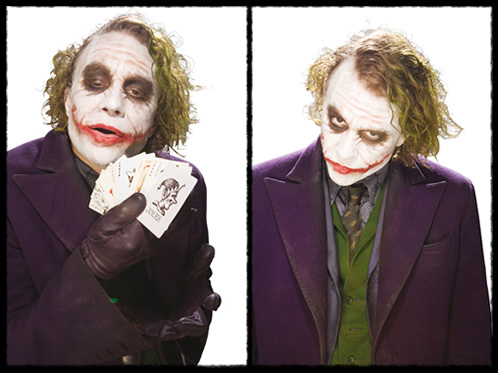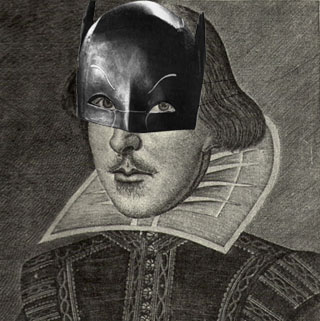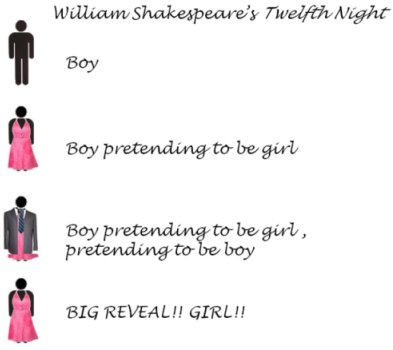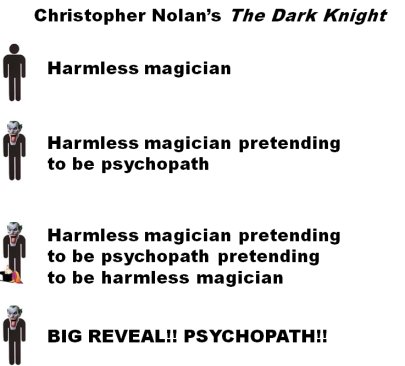THERE ARE HUGE THE DARK KNIGHT SPOILERS IN THIS POST. BE WARNED!
I WILL ALSO PUT A RANDOM STEVEN SEAGAL MOVIE SPOILER AT THE END OF THIS POST. GET EXCITED!
If you’ve seen it, you’ve talked about it. Maybe you cringed. Maybe you cried out. Maybe it totally surprised you, or maybe, like me, you’d heard a little bit about it, but when it actually happened, it still surprised you, and you still cringed, and maybe you still cried out a bit, but you’d rather not draw attention to that, so you won’t mention it except in your blog.
you, or maybe, like me, you’d heard a little bit about it, but when it actually happened, it still surprised you, and you still cringed, and maybe you still cried out a bit, but you’d rather not draw attention to that, so you won’t mention it except in your blog.
Because, sure, Christopher Nolan’s latest Batman film is a dark and compelling exploration of the moral hazards of political necessity. It’s a brave reinvention of the superhero genre. It’s a Boffo Box-office Breaking Batnanza (as Variety might put it if they felt feisty).
But mostly, it’s two-and-a-half hour framing device for a really disturbing scene with a pencil.
You know it’s true. Find out what makes the Joker’s pencil so magical after the jump —
“You want to see a magic trick?”
On its face, the scene is pretty simple. A clown-faced crook named the Joker shows up at a secret meeting of the city’s top criminal bosses — he’s small-time, not on anyone’s radar, and he hasn’t got an invitation.
The bosses try to threaten him, kill, him, or scare him off. But he intimidates them into letting him stay — by slamming one of his attackers’ heads into a table, driving an upturned pencil through the thug’s eye socket and deep into his brain, instantly killing him.
The move is smooth, fluid, and by far the most brutal, merciless act of the summer movie season, short of the release of Space Chimps.
Pencil and meta-pencil
The moment is entirely effective — it’s the most remembered and talked about moment in movies since Indiana Jones climbed in a refrigerator (except in a good way).
But like most truly remarkable movie moments, there’s a lot going on here than meets the eye.
Yes, that’s a pun. Deal with it.
Piercing through the layers
The Joker’s magical pencil moment is similar to the gender-bending that takes place in Shakespeare’s Twelfth Night — it subverts with audience suspension of disbelief itself and deliberately confuses illusion and reality, therefore crafting a “truer” experience than might result from stacking things in a less confusing way.
In Shakespeare’s plays, famously, the parts of women were almost always played either by boys or by Gwyneth Paltrow. Okay, this is confusing enough — by boys.
In Twelfth Night, a girl, being played by a boy, has to disguise herself as a boy in order to survive when shipwrecked alone. The disguised girl then falls in love with a local prince, but can’t do anything about it, because she’s been pretending to be a boy the whole time and doesn’t want to break cover.
(YET MORE SPOILERS!!! IT’S TOTALLY SPOILER SEASON!!!)
At one point, the girl reveals herself to be a girl, and love happens, yadda yadda yadda.
The point is, when the actor reveals himself as a girl by constructing and blowing up a second level of reality, he’s reiterating and reinforcing his initial illusion — when the guy looked like a boy, what the audience saw onstage lined up with their expectations, because he actually was a boy.
But when the guy looked like a girl, he was actually moving farther away from reality — but the audience perceives it as moving closer, because the moment is a big reveal, of a collapsing illusion. You’re stretching and snapping back the audience’s suspension of disbelief so it fits even better than before, sort of like breaking in a pair of shoes.
You’re also hinting that the audience’s perceptions of the real world might be skewed by their presuppositions about what is possible.
Here, I made a chart —
The Falstaff of Felony! The Rosencrantz of Robbery! The Gildenstern of Grand Theft!
In Hollywood movies, special effects artists use camera tricks, computer-generated graphics, animation, fight choreography, wire stunts, squibs, pyrotechnics and all manner of other illusions to depict violent acts realistically (or should I say “representationally”) while committing no acts of violence themselves. The audience knows nobody is really being hurt — not even animals, as we are dutifully informed at the end of every movie — but we watch the illusion and suspend our disbelief.
In The Dark Knight, the Joker, who is very violent — we saw (an illusion of) him gun(ning) down his own accomplice in the very first scene — approaches Gotham’s chief gangsters with a harmless proposition. He will show them a magic trick. He’ll make the pencil disappear. Heath Ledger reads the line pretty straight. It sets up a surprise.
For a suspended moment, the audience is in a similar doubled disbelief to Twelfth Night. We know moviemakers (with the notable exception of Uwe Boll) are in reality nonviolent illusionists, but here we see a violently imagined character further pretending to be a nonviolent illusionist. An entertainer. A special effects artist. It’s a boy pretending to be a girl pretending to be a boy, except with murder instead of petticoats.
And then that suspended moment crashes down and gets a pencil through the eye socket.
The big reveal — the Joker is not just violent, but tremendously violent — moves away from reality. The stunt itself is just a magic trick for the filmmakers, but it feels more grotesquely authentic than if the Joker had just walked in and stabbed someone in the eye.
And we don’t even see the wound. It’s bloodless. The pencil just vanishes. The body drops out of frame. The mind does the rest of the work to make it seem real. Quite an illusion.
Nolan and Ledger have expanded and contracted the suspension of disbelief. They’ve come back to the baseline Batman movie, with its imagined crimes and crimefighters, and firmly hooked the audience and made the imagined brutality all the more brutal.
On top of that, they’ve called the audience’s reliance on their presuppositions of what level of violence is real in their own lives into question — and that goes on to be a major theme for the rest of the film, up to and including the wisdom and compassion of Debo.
Here’s that chart again —
Can you think of other examples of this sort of phenomenon in movies, plays or books? Can we come up with a term for it? Does a term already exist? Were you totally disturbed by the pencil scene? Sound off in the comments!
Oh, and the character played by DMX in Exit Wounds may look like a thug and drug dealer, but he’s secretly a genius computer hacker.
You can thank me for that later.




To be honest, I was more scared by how it the Joker planned it out before hand. By which I mean, he sat down and said to himself, probably aloud, “I’m about to crash a mobsters’ meeting. They’ll probably send a thug to kill me as soon as I walk in the door. How shall I best deal with this while making a good first impression?” *Looks down at desk, sees pencil* *Cue maniacal laughter*
I mean, Jaysus.
Um. In the first sentence, insert “implied that” between “it” and the “the Joker.”
I’m mostly jealous that you wrote the Dark Knight=Shakespearean play post before I did, grumble grumble. Although mine was going to be about Iago…
I guess it’s basically the same thing:
-Actor
-Actor creating false theatrical reality by playing Iago (psychopath)
-Actor creating false theatrical reality by playing Iago (psychopath), who is creating his own false theatrical reality by pretending to be Othello’s friend
-Big reveal: he’s really a psychopath!!! (So does that mean the actor–or at least Shakespeare–is also a psychopath, too?!?! We’ll never know!)
The only difference between Iago and the Joker is that the Joker’s most effective weapon is a pencil and Iago’s is a handkerchief. And Iago manages to indirectly kill Batman–erm, Othello–at the end, making the plot a real Tragedy. But Shakespeare didn’t have to set up a sequel, so you can’t really fault Nolan.
Actually, now that I think about it, maybe that’s not the same thing. First, the audience watching Othello always knows that Iago is a psychopath, because he talks to them in soliloquy–so there’s no real “reveal.” We just realize more and more that he’s a bigger psychopath than he seemed at the beginning of the play.
Second, it’s probably not the same thing because audiences already suspend disbelief when they’re watching a play. You don’t really need any tricks to convince an audience that an actor IS Iago. Audiences tend to buy into that sort of thing pretty easily, especially if the actor isn’t that famous.
How about this, then?
A Midsummer Night’s Dream:
-Good actor (we should hope)
-Good actor pretending to be a bad actor (Bottom)
-Good actor pretending to be a bad actor pretending to be a good actor
-Reveal (in Act V, although we suspected it all along): Bottom really is a terrible actor.
Which makes the actor playing Bottom seem like a better actor, because the audience is now buying his portrayal of Bottom more (“Wow, he is REALLY terrible). Uh, right? Now I’m confusing myself.
OK, I’ve got a good (extremely convoluted) one: Toy Story!
-Pixar animator makes an image of a toy (it’s fake: it’s not a real toy: it’s pixels)
-In the first scene of the movie, the toy (Buzz Lightyear) is a real person fighting aliens.
-But wait, pull back. Buzz Lightyear isn’t real; he’s an image made by an animator for a TV show in the world of the movie
-But wait, he’s also an action figure (an image of the image on TV–which is also an image made by Pixar)
-But wait, the action figure comes to life–so he’s real
-But wait, the action figure thinks he’s a real person–so, according to Woody, he’s not real (“You. Are. A. Toy!”)
-But wait, the action figure can save the day just like the “real” Buzz Lightyear. Thus, all the toys are real, and the audience says, “Yay! They ARE real!”
By the end of it all, I don’t think anyone is thinking “this is just crappy computer animation; I don’t buy it.”
Also: how in the world did I understand that movie when I was ten? This shit is complicated.
Yeah, the big difference with Othello and Midsummer Night’s dream is that the quality of the actor’s work or the actor’s personal moral standing isn’t as evident a part of the metatheatrics the whole time as the actor in Twelfth Night being a dude or The Dark Knight having special effects violence in it. On top of being assumptions, the auidence is always seeing and sort of willfully ignoring the latter.
The tension with a good actor playing Bottom is cool and funny, but I don’t it necessarily gets the to point that the audience recognizes him as a good actor on a second level during the play — something cool is happening there, but it’s a bit different.
And Shana, I did ask you in your thread what your second Dark Knight post was going to be about, although I mostly asked about philosophy, because my Dark Knight post was originally going to be about Schopenhauer.
And Toy Story is a really great example. When you go to the store to buy a Buzz Lightyear doll, the snake eats its own tail.
Well, for one thing, I laughed when I saw the pencil trick. Maybe I’m really sadistic, but I thought it was f***ing hilarious.
What about all of the other Shakespearean characters that give soliloquies? Not all of them are necessarily psycho. Where would they fit in?
And the Shakespearean comparison via Twelfth Night would only be applicable to his time, for now they actually use women to portray Viola on film and on the stage.
Whoa, wait, what about John Travolta in “Hairspray”?!
Interesting Midsummer came up– Christian Bale was in a film version, remember?
That wasn’t much conclusion, more musing and speculative questions…
Haha, now I REALLY want to know what the Dark Knight has to do with Schopenhauer!
Oh, and what happens, I wonder, when you play a Toy Story video game?
Since Shakespeare wrote very specifically for his stage, if you can make a pretty certain determination about how the story is going to be told, you can pretty safely include that in the larger metatext of a piece.
Another good example of that is John Donne’s “The Flea.” It uses the word “suck” a lot to refer to the flea biting people and sucking their blood. Because of the way soft “s”s were printed back in the day, “suck” looked a lot like “fuck.”
Just because we don’t print “s”s like that now doesn’t mean the old comparison drops out of the discussion.
But then again, I’m a pretty strong believer in the idea that art exists diachronically — and that things shouldn’t be dismissed or trivialized because they “come from a different time” or don’t appeal to our (to the extent that “we” are a coherent group at all) own standards.
I had the “time” and context discussion a lot about (political) philosophy in college and talked briefly about it in my thesis. Same sort of conclusions, but more about ideologies and practices.
But I still think for the comparison to work *as well* as it does on first glance, the audience during Shakespeare’s time needs to be separated from an audience watching a movie now because again, women play women in Shakespeare today, so for US, HERE, that extra level of dis-reality doesn’t exist out-right for everyone. Now, some that overthink things (like anyone reading this, no doubt) would know that in the original, Viola was a man playing a woman pretending to be a man when they watch a modern portrayal, and this stays in the back of their mind the whole time they watch; but not everyone in today’s society is even informed enough to be aware of this truth , so there are plenty that just think it’s a WOMAN playing a woman pretending to be a man.
I’m not saying the Shakespeare gender-bending comparison DOESN’T work, I’m just saying it works BETTER if you mean the original audience and not today’s, because that gets more at the spirit of it. the Bottom comparison worked really well, and still can with today’s audience, though. That’s just me, anyway.
Nolan’s own “The Prestige” trades on this kind of thing pretty heavily. Spoilers follow. (Is it possible to avoid spoilers when talking about this subject?) It turns out that one of the films’ two rival magicians is performing elaborate stage magic, while the other’s magic is “real.” But of course, the “real” magic is just as staged as the “stage” magic: both were created by the director, editor, special effects team, and cinematographer.
So you’d think that the “stage” magic is somehow closer to true, right? Maybe not. Because the (even bigger spoiler) “stage” magic turns out to depend on Christian Bale having a secret twin brother, which is just as much of a lie as
David Bowie’sNikola Tesla’s teleportation machine.SPOILERS (ish)
Could the USE of the machine make it less un-real, though? The machine makes a copy of its subject. No, that in itself is not a transportation. BUT. If the original is destroyed every time and replaced by the copy, then the former’s place is taken by the latter’s. So this is a transfer or transportation of EXISTENCE within the world, right? Thus, the machine’s USE is one that creates a transportation. And maybe that can be applied to Borden’s version, too: the USE of the trick transports the identities of the twins from one to the other…
I’m just speculating, please feel free to pick that apart more. It’s probably horsesh*t.
In response to mlawski’s comment about the parallel between Iago and the Joker:
The fact that Iago speaks to the audience in soliloquy doesn’t guarantee that the audience knows he’s a psychopath. This sort of association isn’t drawn out for the audience until he commits an act that displays his psychopathism. So I would say that your parallel is more accurate than the one concerning the boy-pretend girl-pretend boy-girl from Twelfth Night on a more subtle level. The audience knows that the Joker is a crazy criminal, but now how crazy he really is. In Othello, the audience suspects (or knows secretly) that Iago is different mentally, possibly seriously disturbed, but it isn’t revealed how so until they see him do something to confirm their now long-held, but heavily questioned notion that he is. The same with the Joker toward the beginning of Dark Knight. Nolan uses the pencil scene to establish the Joker’s psychosis before you think it’s really going to happen. In the original Batman with Jack Nicholson, it takes some time to build up to the point where we witness the Joker’s psychotic tendencies in action. But The Dark Knight wastes hardly any time in revealing it to make sure the audience knows full well what they’re in for when they see him on or off screen (in their minds). Thus, I like your comparison. The Joker in The Dark Knight is shifting from psycho to humorist and back again constantly, which I think is what makes him so pleasing to the eyes and ears. He’s a manifestation of our urge to be random and experience the unexpected without bounds, because it’s fun. The same reason the Joker continues fucking with Batman and doesn’t really want to kill him.
4th sentence correction…
*not how crazy he really is
The Twelfth Night is not Shakespeare’s most complex gender crazy play that crown is proudly held by ‘As You Like It’:
Male actor plays female daughter of deposed Duke
Male actor playing female then disguises herself as a male to run away into the forrest
Male actor playing female disguised as a man then pretends to be a woman to test a man she is interested in before revealing…..
She is actually a woman (played by a man) and not…….
A woman (played by a man) who’s dressed up and acting like a man pretending to be a woman.
Basicall you have a whole extra level of crazyness!
Hey Fenzel! I discovered this blog via IMDb and was pleasantly surprised when I realized I knew one its writers. We should hang out sometime: Willard and Haas both have my contact info.
Anyway, as to your post, my favorite example of what you describe is in “Sealab 2021.” They do it all the time, reveling in their meta-humor. My favorite moment is when Erik Estrada is playing himself, playing himself. You see, it’s a video game of CHiPs where the avatar is Erik Estrada, but the reveal is that the player is Erik Estrada, but, of course, Erik Estrada is doing the voice for his character. Layers upon layers and yet all the same.
This is a fantastically interesting observation. I’m impressed and I’m saying this as some who spent four years learning about philosophy (and then another four trying to forget it).
i am a movie mistake freak.i do suspend my disbelief and enjoy the movie,but i always notice most mistakes.the pencil trick was very cool and shocking in it’s execution,however,how did he jam a wooden pencil into a hard tabletop leaving it standing perfectly straight??i still loved it and you MUST see it in imax!(sit towards the top of the theater in the center or you’ll regret it!)
here from IMDb!
okay, first: that joker chart is hilarious. i’m seriously repeating that aloud as i type this. and i pretty much agree with prestonius here–christopher nolan does a fucking fantastic job of introducing the levels of the joker’s insanity with just five seconds of film. we know the dude’s crazy–it’s the joker–but we don’t know how crazy until we realize that hey, that pencil just entered that dude’s eyeball, and two, oh man–that dude in the makeup did it.
to answer your question, there is another film that exploits these same qualities: fight club.
psycho new best friend (tyler durden)
psycho new best friend pretending to share the narrator’s interest in the fall of masculinity due to consumerism (fight club)
psycho new best friend pretending to share the narrator’s interest in the fall of masculinity due to consumerism pretends to extend this to the other disaffected youth of america, creating a cult like following by using the narrator’s offical plan (project mayhem)
BIG REVEAL: PSYCHO BEST FRIEND IS ACTUALLY NARRATOR (tyler is the narrator’s split personality)
or something like that!
A comment on “Fight Club” and another example.
“Fight Club” is a great movie. Never ever watch it for the first time as the projectionist. *minor spoilers* That spot where Brad Pitt points at the corner of the screen and says “Look! A reel change dot!” and the reel change dot appears?
IT’S NOT AT A FUCKING REEL CHANGE!
I almost skipped ten minutes of the movie because of that. Oh, and the bits where the film looks like it’s running off the rails? Not funny when you’re babysitting a chronically cranky projector and you don’t know it’s coming. And the way the screen smears out at the end for the credits? It’s called “Shutter Ghosting” and it’s what happens when your projector’s shutter is out of alignment.
Which we had just finished fixing the day before the screening.
My other example of hyper-meta, (or whatever we’re calling it) was a musical I had the misfortune to music direct a few years ago.
It was a show written by a local playwright. It was about a bad local community theater group putting on a bad musical. Sort of “Waiting for Guffman,” right? Just a few MINOR differences.
1. “Waiting for Guffman” was itself funny. This was not
2. “Waiting for Guffman” had GOOD actors pretending to be bad actors. This had really terrible actors.
So let’s summarize the levels of meta here: It was a really bad show about really bad actors putting on a really bad show, put on by really bad actors, badly.
So you think to yourself, “Ah. It must cancel itself out and therefore be hilarious!”
No. No it was not.
The Long Goodbye has this exact trope. Spoilers.
The mobster Marty Augustine has the Marlowe character (Elliot Gould) held for some reason. The threat of violence looms. But Augustine is dapper and handsome. So, a casual psychopath hidden in a mild-mannered man. Now, Marlowe is apprehensive, so Augustine brings in his girlfriend and waxes about his deep love for her. For these moments, the audience (and even the cynical Marlowe) consider that Augustine may not be bad. Augustine gets a Coke for Marlowe in a gracious gesture. Then when he finishes rhapsodizing about his lover, he smashes her face in with the bottle. Completely stunning for the reasons you outlined.
Training Day : Denzel Washinton’s character is cop, cop pretending to be thug, cop pretending to be thug pretending to be cop, omg, thug!
I got a chart for you:
Article
Article pretending to be boring
Article pretending to be boring pretending to be interesting
BIG REVEAL!! Article is BORING!!
DANGGIT! You ruined Exit Wounds! I am utterly crestfallen.
maybe the pencil was CGI ?? (pretending to be a real pencil)
The wife and I just got done watching another example of “the big reveal”…..yes, its the Three Amigos!
Steve Martin, Martin Short and Chevy Chase pretend to be Lucky Day, Ned Nederlander and Dusty Bottoms, three silent film actors who pretend to be good guys for hire, are mistaken as such, still pretend to be good guys for hire until they realize the bad guys are for real, then, big reveal, they really are good guys for hire.
Don’t know if it works, but dangit, the blasted theme song is stuck in my head and it has to go someplace ;)
good ın think
8-D
Did anyone else break out into hysterical, uncontrollable laughter at the pencil scene like I did? I know I was alone in my personal theater… I got kind of excited… a lot of violent brilliance going on.
Dan Alt…Tyler Durden called it a ciggerette burn not a reel change dot. But lol i can see where your comming from with the shutter ghosting, i love that movie and i love the simple effects they threw in there to keep time in progression to the climax. Like at the end of the quote from Pitts character. ”Your not the occupants of your wallet, Your not the car you drive, Your not your money in the bank, Your not your fucking khakis, Your the all seeing all dancing crap of the world.” But how we came from The Dark Knight to Fight Club will always be a mystery
Your not your money in the bank comes 1st in the quote